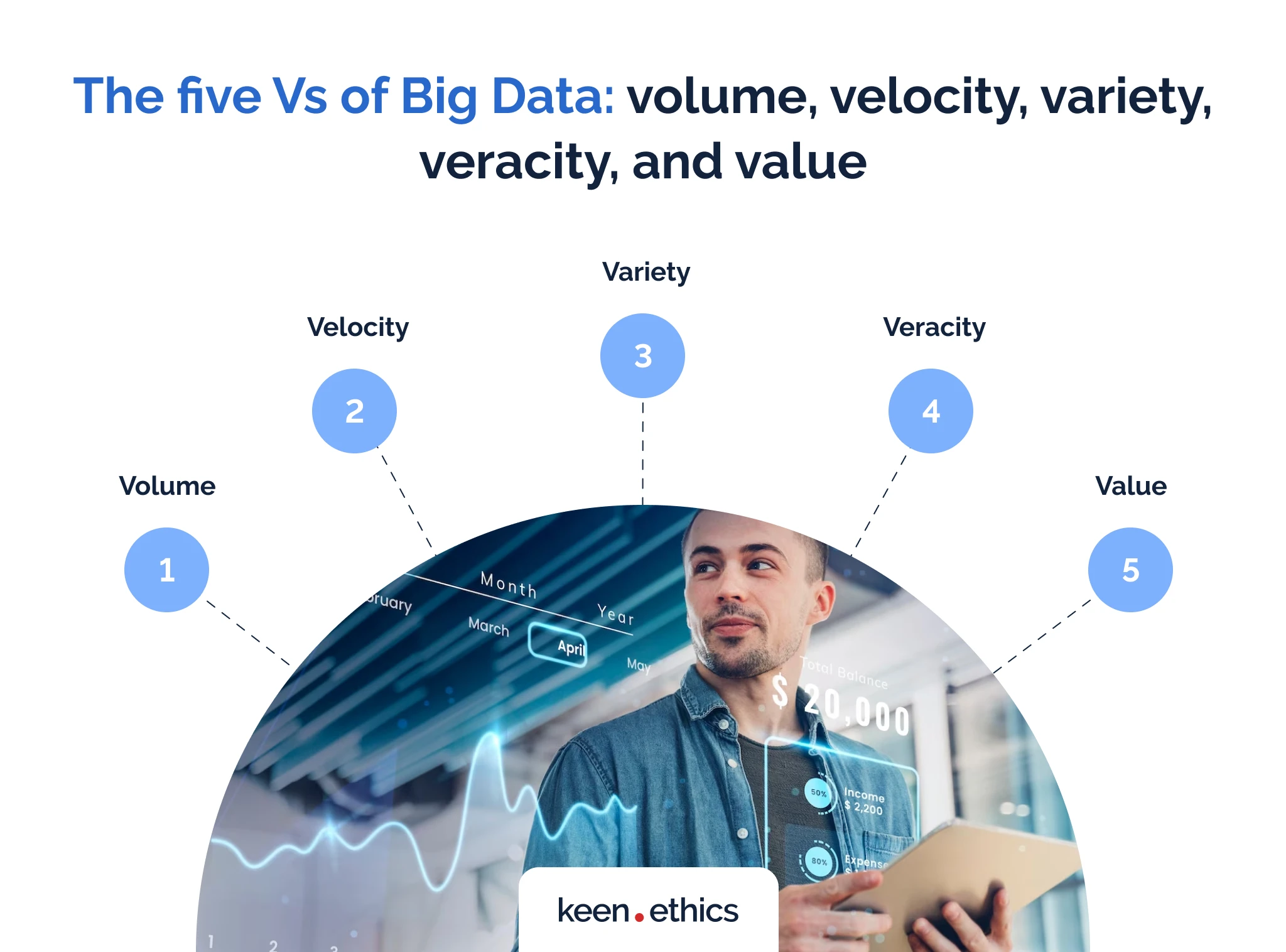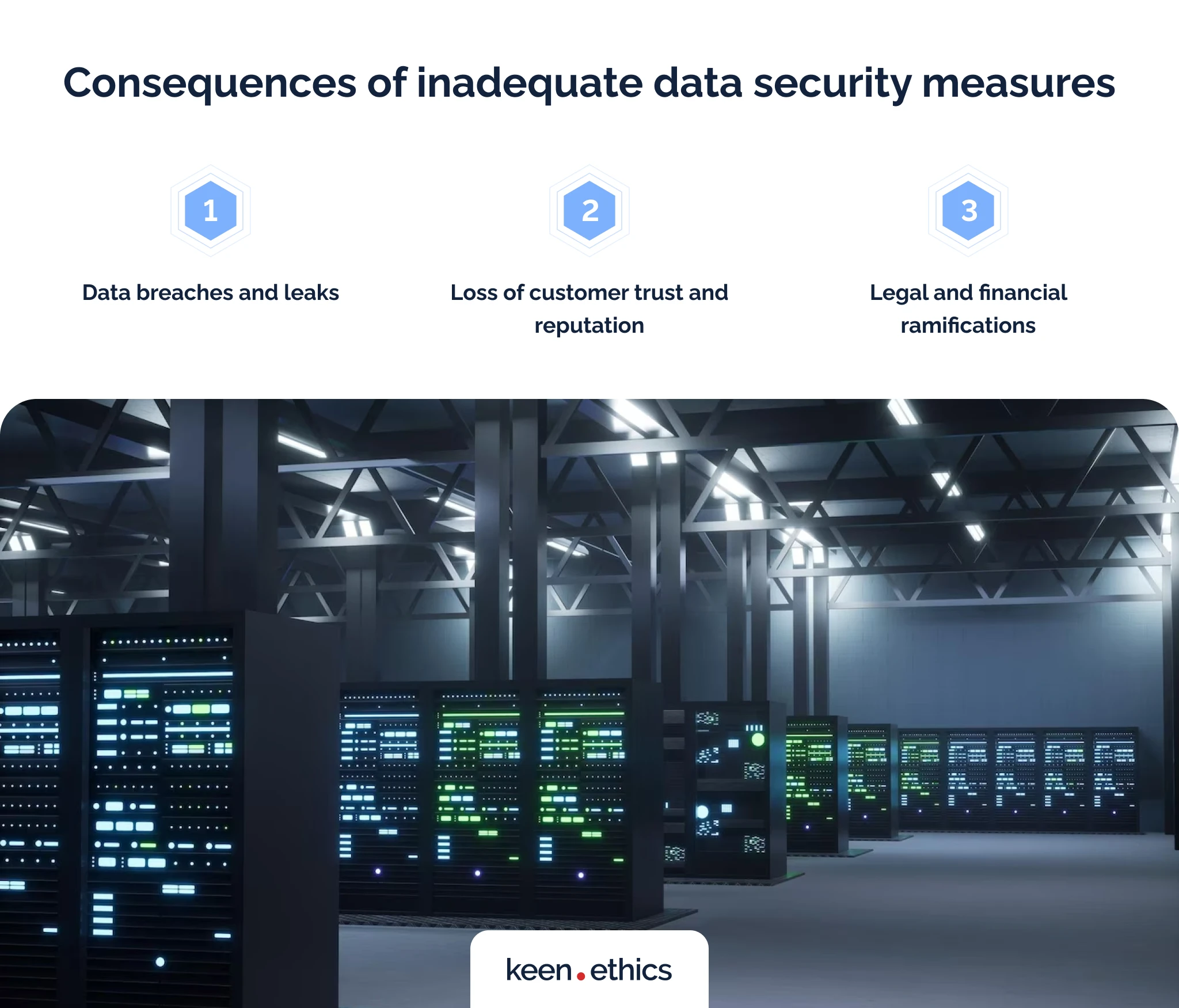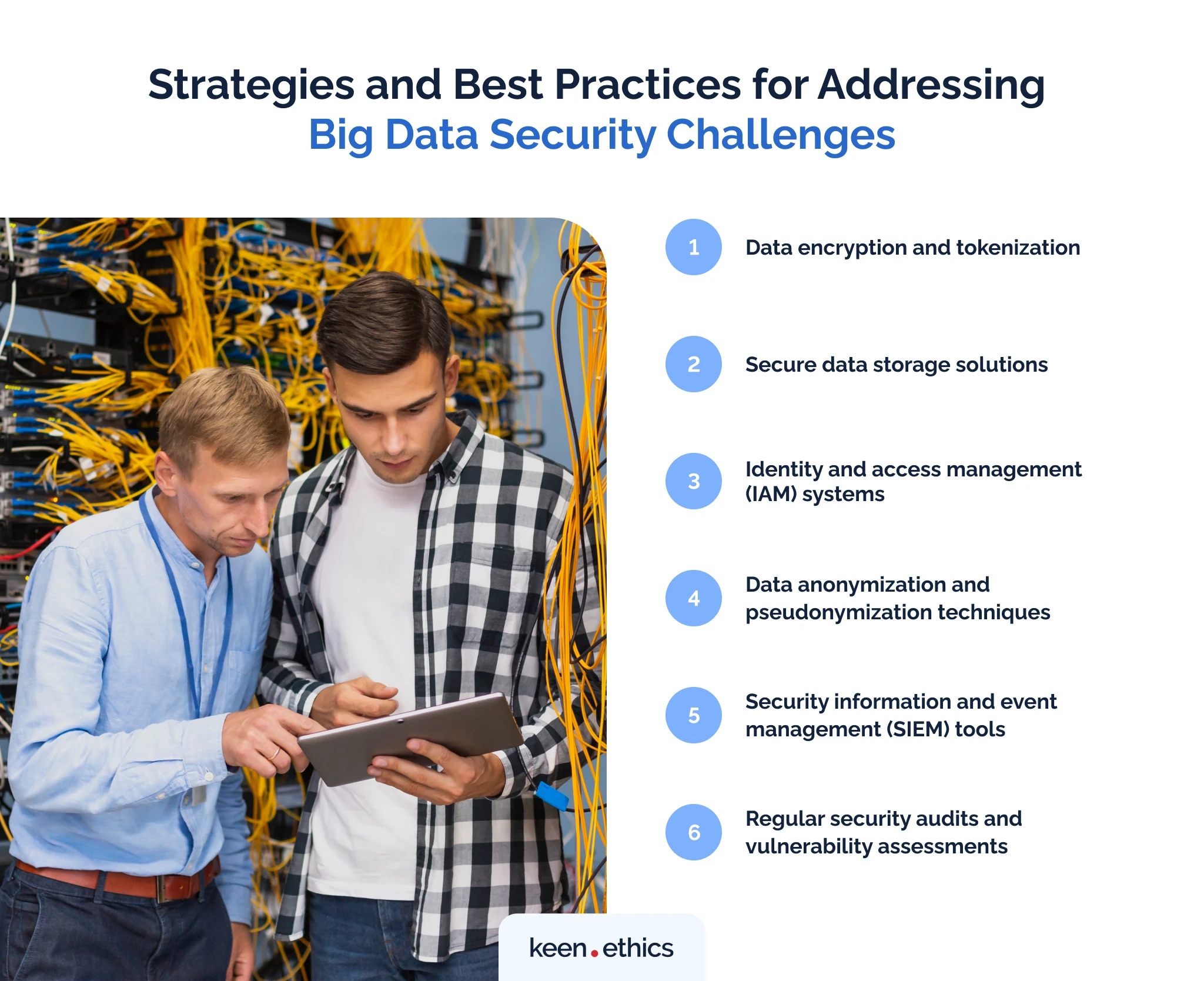Big Data tools are the path to success in the modern business world. Learn how to secure these solutions!
I. Introduction
Let’s imagine the future. You’re using VPNs and encryption to secure your business. Nonetheless, criminals find a way to track your key activities. How can this happen? The answer is simple: Big Data. If someone breaks into third-party servers, they can easily find metadata there. Later, it’ll be possible to reconstruct the key activities in your company through it. We believe this issue will become especially acute with the rise of AI.
Consequently, the main goal of this article is to discuss Big Data security challenges. What will we do in this article? Primarily, we aim to understand what Big Data is and how it functions. Then, we’ll outline the key security problems of Big Data and the ways to mitigate them.
II. Understanding Big Data
Before we review more complex concepts, let’s understand what Big Data stands for.
A. Definition and key concepts
Definition of Big Data
Modern Big Data is a combination of multiple technologies:
- It involves the use of massive databases.
- It requires exceptional data search capabilities.
- It must be able to process tremendous amounts of information.
Ultimately, we can give the following definition of Big Data: Big Data involves large databases that require advanced processing tools; their key goal is to reveal patterns that can later improve decision-making.
The key idea behind Big Data is simple. We have many sources of data in the modern world. In the past, our processing capabilities were insufficient to unite them into one platform. The rise of AI and machine learning finally solved this problem. Big Data is about analyzing and combining data from many sources to create new insights.
Key Concepts in Big Data
What are some key concepts in Big Data? Here are the main elements you should consider:
- Variability. This concept accounts for the inconsistency in data flows. Big Data needs to accommodate fluctuations in patterns.
- Complexity. The key challenge of Big Data includes complex relationships within large-scale datasets.
- Accessibility. This one focuses on making Big Data accessible to users with varying technical skills. Why is this so important? Big Data is a part of data democracy. Consequently, this aspect is essential for widespread data use.
- Privacy. Safeguarding sensitive information to follow ethical and legal standards is central. Modern data mining tools can reveal a lot of sensitive information about users. In fact, it’s possible to deanonymize people via secondary information. Various modern data-related scandals occur due to this capability. You need to close it down to prevent major problems for your firm.
- Scalability. This aspect reflects the ability of systems and infrastructure to expand seamlessly. The volume of data is constantly growing. Eric Schmidt, a former CEO of Google, reports that we create more information every two days than humankind created over all its history before 2003. As a result, we require advanced data management systems to handle this issue.
B. The five Vs of Big Data: volume, velocity, variety, veracity, and value

Today, Big Data has five big Vs. You need to understand these core concepts if you want to capitalize on its trends. Here they’re:
Volume
This aspect refers to the sheer size of data generated. Big Data exceeds traditional processing capabilities. In this light, using greater processing power and newer methodologies is crucial. Regarding greater processing power, humankind invests major funds into quantum computing and better silicon processors. Concerning new methods, we’re seeing an increasing impact of AI and machine learning.
Velocity
This aspect describes the speed at which data is generated and analyzed in real time. The whole idea of Big Data is to analyze as many data points as possible. Consequently, every Big Data engineer must actively work on new tools for high-speed analysis.
Variety
Big Data includes diverse data types. What information can such a system encounter? There’s structured, unstructured, and semi-structured data. Your system must be able to handle any type of knowledge if you want it to succeed. More importantly, this system must be able to create combined output. You should have the ability to connect both structured and unstructured information.
Veracity
There’s a common expression in mathematics: garbage in, garbage out. It’s not enough to have an advanced methodology for handling data. You should also have the ability to verify it. For instance, the Soviet planned economy didn’t have problems with calculation per se. The Soviet Gosplan (State Planning Committee) could easily calculate a general plan for the country in the 1980s. What destroyed it was the absence of high-quality information. Various local enterprises were hiding their real capabilities to get relaxed production targets. This issue can easily befall modern firms, too, as they’re, essentially, small-scale planned economies. In this light, you should emphasize data quality and reliability. How to do this? You must have both great incentives and strong control tools.
Value
Not all data is equal, too. Some pieces of information have greater value than others. Consequently, your goal is to stress the importance of extracting meaningful insights from Big Data. During COVID-19, information on its spread was more important. Today, data about international oil prices can be more vital. You should always try to understand what your priorities are in terms of data.
C. Technologies involved in Big Data processing and analytics
There are multiple big technologies for Big Data analytics. Here are the key frameworks you should consider in your everyday work:
Hadoop
Hadoop is an open-source framework for distributed storage and processing of massive datasets. It uses commodity hardware to offer fault-tolerant solutions for Big Data. Some key Hadoop technologies are the Hadoop Distributed File System (HDFS) and MapReduce programming paradigm. The key goal of these technologies is to enable the storage of large files. Platforms that use Big Data, such as ChatGPT, require many terabytes of information. Only distributed storage can guarantee long-term success in this regard.
Spark
Spark is a fast general-purpose cluster computing system. It was designed for Big Data processing. What are the main technologies within it? It uses in-memory data storage, which supports diverse workloads. The most essential tasks it can do include batch processing, iterative algorithms, interactive queries, and streaming. All of them provide improved performance over traditional MapReduce. The idea is to optimize processing to minimize the time you spend sending data between different devices. For example, Spark helps group calculations on separate servers. Consequently, they share data only when it’s truly necessary.
NoSQL Databases
NoSQL databases are also a major technology for modern Big Data. Non-relational databases were designed specifically for large-scale data storage and retrieval. They offer flexible schema designs to handle diverse data types and high volumes. NoSQL frameworks enable other storage formats instead of storing data in traditional tables. Because of this, using these tools can help you work more efficiently.
Machine Learning and Artificial Intelligence
Lastly, we also need technologies that process a tremendous amount of data. Yes, a strong organization-centric principle simplifies work for modern analytics tools. Nonetheless, those technologies aren’t sufficient for success. As a result, machine learning algorithms and AI techniques have become vital for Big Data. Why are they so important? Those technologies can analyze vast datasets. Consequently, they have the capacity to uncover patterns, enabling predictive modeling and anomaly detection.
III. Big Data Security: The Need for Robust Protection
It’s not difficult to understand the key problems of Big Data if you look at its essence. This technology has significant issues with security. Why? Big Data uses a tremendous number of tools. More importantly, it interacts with large volumes of information. In this light, the possibility of data leaks involving sensitive information is high. This section will review those issues with security in-depth.
A. The significance of data security
Data security for Big Data tools is among the key aspects you should consider. The potential for large-scale attacks on Big Data instruments is significant. It uses database and calculation software. At all those stages, criminals can intervene to steal information. More importantly, Big Data tools themselves create sensitive data. In the past, various information leaks from social media, for instance, were mostly non-critical. Why? They involved anonymized knowledge. Current Big Data tools are strong at deanonymizing people. In this light, they’re especially dangerous. What should you do to improve security? We believe modern business needs better tools for encrypting data and making it less sensitive. Further paragraphs of this review will look at those features in-depth.
B. Consequences of inadequate data security measures

What are the ultimate consequences of inadequate data security measures? In our opinion, three major issues can befall you. In many ways, their key danger is that they affect modern companies all at once.
1. Data breaches and leaks
You’ll inevitably face data breaches and leaks if you don’t invest enough in data security. The reasons for data leaks can be extremely diverse. Here are the key pathways:
Inadequate Security Measures
This problem involves the lack of robust encryption, access controls, and authentication mechanisms. As a result, criminals can steal data more or less directly by simply accessing some files. This happened to Panion, a Swedish social media app. Cybernews discovered that the developer behind it used to store most user data in an Amazon cloud without password protections and encryption. Any person with a link to this server could access sensitive data without barriers.
Obviously, this case involves many other issues, which we’ll describe below.
Insufficient Data Governance
Another issue for secure Big Data is data governance. Poor management and oversight can easily lead to unregulated data handling practices. All this ends in potential vulnerabilities within Big Data ecosystems. For example, a common challenge is that many people use low-quality passwords. More importantly, some individuals use home computers and accounts to access company analytics. They may have viruses or other problems with insufficient protection. Only proper data governance can prevent those issues. You need active training for your workforce to eliminate those concerns.
Human Errors
The issues we’ve mentioned above often result from human errors. Mistakes such as misconfigurations or negligence are the key contributors to data leaks. What should you do with them? The key goal is to train employees and, more importantly, have thorough selection processes.
Third-Party Risks
Another major difficulty with various Big Data tools is that they rely on many third-party solutions. You can have perfect security in your company. Your partners, however, may be much less responsible. Weaknesses in security practices of external vendors or partners handling information are a gigantic issue for Big Data security. For this reason, you should consider closed-cycle systems. The fewer outside technologies you use, the lower the chance of third-party leaks.
Malicious Activities
Intentional attacks such as hacking and office intrusions are also a major threat. Some criminals can use social engineering to get valuable information. In this regard, social engineering stands for deceptive actions that trick stakeholders into giving away information. For example, some criminals impersonate colleagues to get into computer systems.
2. Loss of customer trust and reputation
Ultimately, all types of unauthorized access end in major reputation damage. Users of social media often reveal sensitive information in their dialogues. Most banks hold the life-long results of someone’s work. If information leaks, it can end in devastating damage to clients. In some cases, the relevant individuals may lose their jobs due to private opinions displayed in personal communication. In other situations, people lose their entire life savings because of leaks. This can occur when hackers enter computer systems and directly steal money. In other situations, banking information or social media discussions may “help” criminals target particular individuals. Obviously, any situation of this type can be devastating for the reputation of a social media company. People expect significant protection of their information. Few individuals will consider using your service if you fail to deliver it.
3. Legal and financial ramifications
Ultimately, the most significant leaks can easily affect millions of people. All this will inevitably lead to lawsuits. In many data leak situations, large companies had to pay tremendous sums to their clients. For instance, the Equifax settlement involved tremendous compensation. The business was ready to pay up to 425 million dollars. For a small company, this outcome can be devastating.
IV. Security Issues and Challenges in Big Data

Ultimately, modern Big Data has several major security issues. We must review this information first to understand how to secure modern information-centric solutions.
A. Data privacy and confidentiality
Above all, modern Big Data security faces problems with privacy and confidentiality. Let’s review those issues in depth:
1. Protecting sensitive information
Many Big Data models have major problems with protecting sensitive information. Why do they occur? We’ve already mentioned the mechanism behind security issues, but let’s review them in detail. The core advantage of Big Data isn’t the amount of information it analyzes. In reality, Big Data is valuable for its ability to mine new data. Suppose you have two data sets about the weather in a particular location and car accidents. If you connect them, creating an interesting association will be possible. Later, this association can affect policy as governments restrict driving during bad weather. Big Data works similarly: it helps create networks of connections for analysis. The only difference is the scope of connections. If they were limited to two or three aspects in the past, now one can connect thousands of them. Big Data, in short, creates new valuable knowledge out of old.
What’s the core problem with this approach? In our opinion, it’s two-fold.
User Profiles
Firstly, Big Data helps create realistic psychological profiles of certain individuals based on secondary data. Loyola University, Maryland, reports social media sites often know more about their users than their family members. For example, those services predict user interests before they even arise. Many online testimonies show social media ads predict interest in music or language learning before a person starts searching for courses. If leaked, this information means Big Data can reveal extremely sensitive data.
Deanonymization
Secondly, a major problem of Big Data is that it can also reveal personal information without user consent. Every time we use the Internet, various services record our behavior. In this way, diverging companies can create realistic profiles of our interests. What’s the challenge here? Those realistic profiles are often account-agnostic. Many trackers connect you to certain devices or locations. Why is this so dangerous? If you decide to hide your information, doing this will be almost impossible. Big Data tools can track tremendous amounts of data to deanonymize people. As a result, tools such as Tor Browser are likely to fail. Why is this so important? In the future, hiding from government or corporate surveillance will be increasingly difficult.
2. Complying with data protection regulations (e.g., GDPR, CCPA)
Ultimately, it’s increasingly difficult for Big Data tools to comply with modern data protection regulations such as GDPR. In many ways, this technology in its full form can’t be compatible with them. Consequently, it’s necessary to create several major restrictions for it. In our opinion, these restrictions will likely touch upon several aspects. Above all, it’ll be illegal to use Big Data for user profiling in its current form. We need to create tools that can hide information behind high-quality barriers. Encryption of potentially vulnerable data can be a perfect choice. A potent option is prohibiting social media companies from directly analyzing user accounts. They should only be able to collect data on user cohorts. In short, the process of adhering to Big Data regulation is complex.
B. Data storage and management

Another issue to consider is data storage. It can also create major dangers.
1. Securing data at rest, in transit, and in use
In all its forms, Big Data contains a lot of vulnerable information. It represents a danger for average users at all times. Even if one uses anonymization for their information, some tools may appear to reveal hidden connections. Ultimately, this information means we must secure data at rest, in transit, and in use. In this regard, we require advanced encryption tools and constant monitoring of our computer networks. A major defense against intrusion is also employee training. Two goals exist here. You must ensure hackers don’t enter computer systems storing sensitive information. In case you fail at this, they shouldn’t be able to get any vital data.
2. Ensuring data integrity and preventing data corruption
We also have a lot of fake data in the modern world. Why is this so dangerous for Big Data? We’ve already mentioned what destroyed planned economies. They couldn’t collect high-quality information for planning. They got garbage information into the models and had garbage outside. Modern Big Data models face a similar issue. They can genuinely process gigantic amounts of information. The key challenge is that this information can be completely incorrect. If several departments in your business hide real production results, your model will work perfectly but won’t give realistic predictions.
Consequently, a major challenge of data security management is ensuring this data is correct. Problems with data integrity due to corruption can easily end in massive damage to a firm. After all, one can use this information to make incorrect business decisions.
C. Access control and authentication
You should also think about modern access control and authentication tools. They’re often the best way to protect information.
1. Managing access to sensitive data
Various types of threats come from inside. Your employees may be using weak passwords. In other cases, they can be vulnerable to social engineering. Some competitors even go as far as to send spies to other companies. For example, according to CNET, Google has recently encountered multiple attacks from insider spies. In this light, a core problem arises: many firms give too much access to certain employees. As a result, your core goal is to recreate the existing access systems. We recommend going as far as to install zero trust frameworks in your business. Any sensitive data should be accessible only to the most trusted workers and only in certain circumstances.
2. Implementing robust authentication mechanisms
You should also have robust authentication mechanisms. We believe password-based systems are no longer secure. You need to consider other forms of authentication control. In this respect, implementing several new authentication mechanisms is a potent approach. What are those? The most promising models include biological authentication. A strong idea is to couple voice, fingerprint, and eye scans with advanced passwords. You can also tie all those models to two-factor authentication via mobile phones. In this way, hackers must possess physical access to your facilities and equipment to see internal files. Without those methods, breaking into Big Data systems is simple. All that hackers have to do is find out the relevant passwords. This is easy to do via social engineering or even authentication system bugs.
D. Data provenance and lineage

We’ve already mentioned that data quality is among the major problems for Big Data. Let’s review an adjacent problem:
1. Tracking data source and modifications
The problem of data quality would have been relatively easy to solve if you had absolute control over its collection. What’s the real problem of Big Data security? We usually don’t have full control over the stored data. In the end, this information means you can face issues with third-party leaks. The most dangerous lies have major bits of truth within them. In this light, an inability to track data sources and modifications may lead to significant information corruption. As a result, your key goal should be to create tools for tracking and verifying information. In numerous instances, third-party intrusions can be devastating for long-term data quality.
2. Ensuring data accountability and transparency
In our opinion, the only way to ensure data accountability and transparency in the modern data industry is to have clear standards. What should modern companies do? Firstly, it’s essential to establish partnerships with your data providers. You should deliver clear standards for data collection and processing. Secondly, a strong step is to advance data security laws. The best approach to promoting Big Data tools is to have clear policies for them. When all firms in this market understand how to work with those platforms, data accountability and transparency will be easier to ensure.
E. Advanced persistent threats and sophisticated cyberattacks
Lastly, you can also become a victim of targeted attacks. The key problem for many companies is understanding that they’re the target of an attack in the first place. A widespread situation is that hackers enter systems more or less unseen. For example, they can find elements that have no password protection. Often, this issue happens because of Amazon cloud misconfiguration. Spiceworks reports on several major cases that occurred due to, for instance, difficulties with passwords. Detecting those attacks is almost impossible. You must have strong monitoring to see potential attack pathways in such situations.
What can one do to solve these problems? In this regard, you should have periodic security audits. For example, a strong idea is to have penetration testing to understand potential entry paths. We also recommend using security-centric AI. It can detect strange patterns in your security. As a result, finding the criminals with access to your cloud or other storage frameworks is generally easier.
V. Strategies and Best Practices for Addressing Big Data Security Challenges

Ultimately, we believe several key security strategies for overcoming privacy issues with Big Data exist. It’s time to review the key things you can do:
A. Data encryption and tokenization
Encryption is one of the best tools for preventing all types of data breaches. Why? Breaches into modern computer systems are likely. If you encrypt and tokenize your data, this access path will be more or less useless. The hackers will also have to find the relevant decryption key. It’s relatively easy to enable those tools for Big Data. After all, Big Data servers typically have strong processing capacities. Consequently, they should have no problems adding encryption processes into calculations. This action will likely take at best 1% of the processing power. In turn, it will protect you against the majority of breaches. For instance, the 2011 Sony breach was minor because it used to encrypt user accounts properly.
B. Secure data storage solutions
Another important entry point includes storage. As we’ve seen in the examples above, many hackers enter computer systems through badly configured clouds. In this light, the most rational solution is to consider secure data storage. Here are the core strategies you can use to ensure high security:
- Encrypted External Hard Drives
- Cloud Storage with End-to-End Encryption
- Network Attached Storage (NAS) with Encryption
- Solid-state drives (SSDs) with Hardware Encryption
- Self-hosted solutions with Strong Access Controls
In short, two types of solutions exist in this case. You should focus on encryption and strong access control. The latter elements are primarily administrative tasks. You must be able to train managers and workers to respect proper access practices.
C. Identity and access management (IAM) systems
Ultimately, we recommend going as far as using identity and access management systems. The aforementioned zero-trust frameworks are an example of this technology. What do they do? They restrict access based on multiple identity-related factors:
- Those systems check your biological markers. They can look for fingerprints or eye scans.
- They review the location from which you access data. Tying access to particular locations is possible if you want maximal security.
- Those systems use advanced passwords and two-factor authentication tools.
Yes, they won’t be able to protect you against physical intrusions. For example, Target faced a physical attack on its system, with core devices being an attack vector. Nonetheless, they’ll allow you to concentrate more security efforts on internal offices.
D. Data anonymization and pseudonymization techniques
Anonymization is essential if you consider the deployment of Big Data. What should one do here? These are the core steps:
- Randomization: shuffling or replacing values to break the direct link between individuals and their data.
- Generalization: Aggregating or summarizing data by removing details to create broader categories.
- Masking: Partially or fully replacing sensitive information with generic or dummy values.
- Tokenization: Replacing sensitive data with unique tokens or identifiers while maintaining referential integrity.
- Noise Addition: Random noise is introduced to the data to make it more challenging to identify individuals while preserving overall patterns.
E. Security information and event management (SIEM) tools
SIEM systems help find irregularities in your data protection systems. Their key goal is to enable you to see massive issues before they become critical. What are some core functions in this case? Here they’re:
- Log Collection: Aggregating and collecting log data from various sources.
- Event Correlation: Identifying patterns and correlations across different systems.
- Alert Generation: Generating alerts for suspicious activities based on predefined rules.
- Dashboards and Reports: Providing visual representations of security data for analysis.
- Incident Response: Supporting investigation and mitigation of security incidents.
- Real-time Monitoring: Monitoring and analyzing events in real-time for quick threat detection.
- Compliance Management: Assisting in meeting regulatory compliance requirements through monitoring and reporting.
F. Regular security audits and vulnerability assessments
Lastly, we also recommend you hire outside firms for security audits. Let experts review your frameworks and understand if they’re secure enough. A typical security audit involves the following steps that alleviate Big Data security concerns:
1) Analysis of existing solutions;
2) Upgrade of the existing solutions;
3) Addition of new security tools;
4) Analysis of the open-source tools you’re using;
5) Penetration testing (in this case, ethical hackers try to break into your system);
VI. Real-World Examples of Big Data Security Challenges

The best way to understand how to improve data security is to look at the real-life cases. We have the following provider and platform examples in this respect.
Equifax (2017)
Overview
Equifax, one of the largest credit reporting agencies, experienced a massive data breach in 2017. During it, hackers gained unauthorized access to sensitive personal information. Names, Social Security numbers, birthdates, and addresses leaked. Ultimately, the leak affected approximately 147 million people. As mentioned before, Equifax had to pay millions of dollars for its inability to protect users.
Lessons Learned
- Security Measures: The breach underscored the importance of robust cybersecurity measures. It highlighted the need for secure storage and encryption of sensitive data. The company failed twice. Above all, it failed to close access to its internal data. More importantly, its data became vulnerable after the breach. Many types of information were more or less unencrypted. That’s why hackers were able to access it.
- Timely Response: Equifax faced criticism for delays in discovering and disclosing the breach. The incident emphasized the necessity of a prompt and transparent response to security incidents.
Yahoo (2013-2014, disclosed in 2016)
Overview
Yahoo, a major internet company, suffered two significant data breaches. The first occurred in 2013, affecting over one billion user accounts. The second, which happened in 2014, compromised 500 million accounts. Wikipedia has a detailed article on all aspects of those breaches. What information was leaked during the breach? The hackers primarily managed to steal account data. This data included names, email addresses, and hashed passwords. Ultimately, criminals could easily use this information to enter user accounts illegally.
Lessons Learned
- User Authentication: The breaches highlighted the importance of authentication and cookie protection tools. In the aftermath, Yahoo encouraged users to update their passwords and use two-factor authentication.
- Data Encryption: The incident underscored the significance of encrypting sensitive user data. Often, it was possible to access user information via cookies. Large-scale platforms store a lot of sensitive user data. As a result, they need to actively consider features that prevent such breaches.
Alibaba (2015)
Overview
In 2015, Alibaba’s ecommerce platform, Taobao, experienced a major data breach. It exposed the personal information about millions of users. The breach involved a leak of usernames and passwords. Why was this so dangerous? It had a potentially negative impact on users’ online accounts and transactions. Some purchases could have been used to target certain individuals based on wealth. Blackmail for particular purchase choices was also a possible outcome. Alibaba’s leak was smaller than other ones. However, it highlighted real transactions, according to the Guardian, making every leak more acute.
Lessons Learned
- User Education: Alibaba focused on educating users about online security after the incident. In many cases, problems could have been avoided through better password generation. As one may see, the importance of creating strong passwords is high in all outlined cases.
- Continuous Monitoring: The incident emphasized the need for continuous monitoring of security systems. In this case, the breach was undetected for a long time. Proper detection systems could have helped find it before it became so acute.
Ultimately, all these case studies highlight the importance of proactive cybersecurity measures. You need timely responses to incidents and ongoing efforts to educate users.
VII. Future Outlook: Emerging Technologies and Trends in Big Data Security

In the future, the field of Big Data security will likely see major transformations. They’ll stem from large-scale innovations. What are those? Let’s review them:
A. The role of artificial intelligence and machine learning in cybersecurity
The first vital innovation is undoubtedly the rise of artificial intelligence and machine learning. In many ways, modern artificial intelligence became possible due to Big Data. ChatGPT and similar platforms use terabytes upon terabytes of information. We can also use their prediction and generative capabilities for Big Data analysis. For example, they’re perfect for combating Big Data privacy concerns. AI tools can review interactions in core data analysis platforms to prevent breaches. Here are the core uses of this technology:
- Anomaly Detection
- Predictive Analysis
- Behavioral Analytics
- Automated Incident Response
- Data Encryption and Privacy
B. The impact of quantum computing on data encryption
We’re likely to see the rise of quantum computing in the upcoming years. Those computers will be several million times better at calculations than current silicon ones. This factor will play a positive and negative role in Big Data. On the one hand, it’ll enable us to process more data than ever in the past. On the other hand, breaking into old encryption protocols will be incredibly easy. Consequently, quantum computing will likely lead to the rise of new standards in data encryption. We will witness the appearance of quantum-resistant security.
C. The rise of privacy-preserving data processing techniques (e.g., federated learning, homomorphic encryption)
Lastly, we’re interested in the rise of new data storage methods. Their key goal is to decentralize information. In this way, we prevent situations when it’s possible to hack one server and get all the data.
- Federated Learning: this case involves privacy-preserving ML where models are trained on decentralized devices. They share insights without exchanging raw data centrally.
- Homomorphic Encryption: this technology secures data by allowing computations on encrypted information. Such an approach helps preserve privacy while enabling analysis without decrypting sensitive data.
VIII. Conclusion
All in all, modern Big Data tools have severe security flaws. You should always consider them while using those instruments. It’s possible to hack into databases or deanonymize data. Is this the reason to abandon Big Data? In our opinion, no. Its benefits for AI and financial analytics are too significant. Consequently, you should focus on encryption and access control while using this technology. Keenethics can help in this regard: we have over eight years of experience creating such solutions.
Create a secure Big Data solution together with Keenethics.












